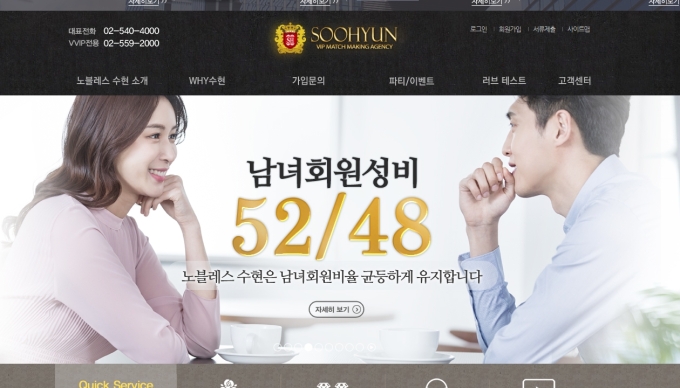Women dominate the clientele at Korean marriage agencies, which is often used to justify extra costs for joining. But this differential pricing goes well beyond just sex, both reflecting and shaping consumers’ notions of the “perfect” wife too. And it seems she’s neither highly-educated, highly-earning, nor even over 32.
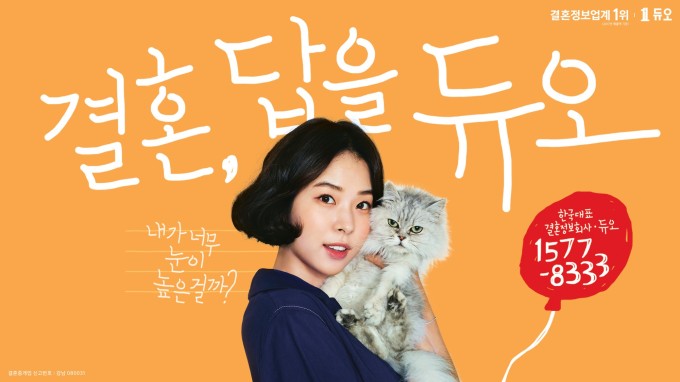 Estimated reading tme: 12 Minutes. Image source: Duo.
Estimated reading tme: 12 Minutes. Image source: Duo.
Korea’s largest matchmaking-agency Duo, on the rebound after experiencing massive reductions in sales in recent years, claims to be voicing “the inner minds and concerns of young Koreans” in its latest series of ads. With this particular one though, its “Am I just being too picky?” subhead seems hilariously out of touch. As if young Koreans did have the financial resources to marry, but were just too stuck-up to consider looking for a spouse on the internet. Because damn millennials ruin everything, right?
It’s so awkward, it immediately reminded me of this ham-fisted, Singaporean government birthrate campaign ad that came out in the 1980s, which Asian Studies students have been laughing at ever since:
But my source didn’t find Duo’s ad so funny, accusing them of gaslighting:
 “What amazing gaslighting. Those marriage agencies don’t have many female customers, so they resort to harmful gaslighting tactics.”
“What amazing gaslighting. Those marriage agencies don’t have many female customers, so they resort to harmful gaslighting tactics.”
Actually, it was difficult to avoid the male version of the ad with the same caption. Yet the wider accusation about marriage agencies begged investigation. Surely there was something much more substantial behind the barbed tweet, I sensed, than merely snapping at one single ad?
My first searches did little to support that gut feeling. In fact, it turned out that until a few years ago, Duo used to have more women than men. Then in the early-2010s the numbers of men signing up starting rising, and by 2014 there were more men than women in both Duo and second-place rival Gayeon. These shifts can be seen quite clearly below in the table for Duo and Gayeon and graph for Duo respectively:
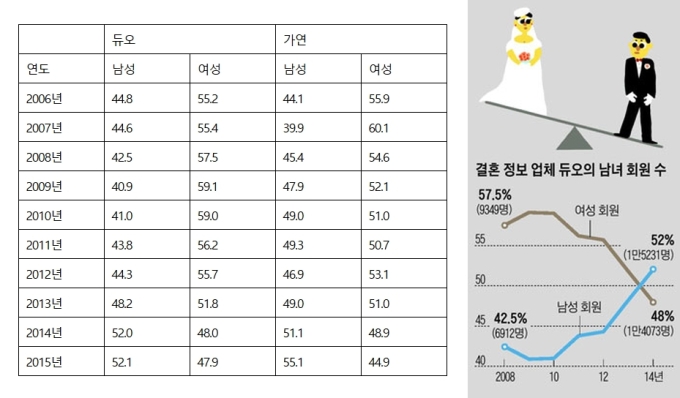 Sources: Yonhap, Chosun.
Sources: Yonhap, Chosun.
At the time, Bae Joon-yong at the Chosun Ilbo accounted for the shift by the (alleged) rise of “herbivore men,” whom he defined as men rejecting dating in their 20s, but still open to marriage once they hit their 30s. Statistics speak louder than buzzwords however, and its difficult to argue with Namuwiki’s contention that the increasingly high numbers of female fetuses aborted in the late-1980s were responsible, with the ensuing lonely men coming of marriage age. Especially when those numbers are presented in graphical form:
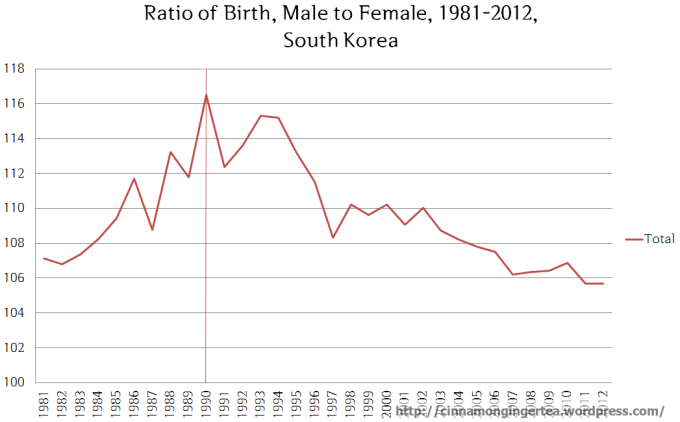 See here for my examination of the likely effects on Korea’s “gender wars.” Source: Cinnamon Ginger Tea; reprinted with permission. Note that the WHO considers a natural birth sex ratio to be 105 boys for every 100 girls.
See here for my examination of the likely effects on Korea’s “gender wars.” Source: Cinnamon Ginger Tea; reprinted with permission. Note that the WHO considers a natural birth sex ratio to be 105 boys for every 100 girls.
Unfortunately, very little information exists for the 2016 to 2019 period. But we are just talking about statistics from three years ago. It would only be natural to assume that the trend for more men continued.
So imagine my surprise at learning that it appears to have completely reversed. In fact, the sex ratios have already returned to their female-dominated 2006 levels.
First, consider this December 2018 interview of an anonymous former matchmaker by Na Jin-hee at the Segye Ilbo (my emphasis):
—결혼정보업체 회원의 성비는 어떤가?
“예전에 비하면 많이 나아졌다지만 여전히 여성 회원이 남성보다 훨씬 많다. 메이저 회사는 여성 대 남성 비율이 6:4에서 5.5:4.5 정도로 추정된다. 영세 회사는 훨씬 더 차이가 크다. 8:2에서 9:1까지 가기도 한다.
남자 수가 적으니 자연히 남자 회원에게 서비스가 훨씬 많다. 전문직 남성의 경우 가입비를 할인받거나 아예 내지 않는다. 만남 횟수도 훨씬 많이 제공된다.”
—What is the sex ratio of customers at marriage agencies?
“The ratios have greatly improved, but there’s still many more women than men. Larger agencies estimate female to male ratios of 6:4 to 5.5:4.5. But the differences are much greater at smaller agencies. Sometimes they’re as high as 8:2 or even 9:1.
As there are fewer men, they naturally receive preferential service. “Professional” men [e.g., lawyers, doctors, and Samsung employees] receive discounts on membership fees, or may have them waived altogether. They get many more dates arranged [than women do] too.”
And another article by the same author published an hour(!) later:
◆아르바이트 회원에 남녀 성비 불균형… 업체는 ‘쉬쉬’
…애초에 남녀 성비가 맞지 않아 결혼 성사가 어렵다는 비판도 있다. 결혼정보업체의 여성회원 비율이 남성보다 상당히 높은 건 업계의 공공연한 비밀이다. 익명을 요구한 업계 관계자에 따르면 영세 업체일수록 이 같은 현상은 심해져 여성 비율이 90%에 이르기도 한다고 전해진다.
◆Fake, “part-time” customers used because of unequal sex ratios…Agencies say “Shhh!”
…There is also criticism that the very first step to finding a spouse—meeting new people—is difficult because of the unequal sex ratios.
The fact that marriage information agencies have considerably higher numbers of women than men is an open secret. According to industry officials who asked for anonymity, it is even worse at smaller companies, where the proportion of women may be as high as 90 percent.
By all means, this does not constitute proof. The claims of writers who use such cliched devices as “common knowledge” and “anonymous industry sources” should always be taken with a grain of salt, especially those who won’t acknowledge earlier sources that flatly contradict their claims. Be that as it may, in June 2019 Pyo Ju-yeon at Newsis offered slightly more evidence for the new ratio at Gayeon at least, in the form of “[an unspecified disclosure on the 16th by] the Korean marriage agency industry”:
대부분 회사들은 가입 금액에서 남녀 차등을 두고 있다. 차등이 가능한 이유는 성비가 맞지 않기 때문이다. 여성회원이 남성 회원보다 많기 때문이다. 가연의 경우 여성과 남성비중이 55대45정도다. 듀오의 경우에도 비슷한 수준이다. 이 때문에 결혼정보업계에서는 연애할 때는 ‘여성우위’, 결혼할때는 ‘남성우위’라는 말을 하기도 한다.
Most marriage agencies have different signing-up charges for men and women. The difference is possible because the sex ratio of customers is skewed, with far more women than men. In Gayeon, the ratio of women to men is 55 to 45; in Duo, it is similar. For this reason, people in the industy use the term “female advantage” to describe the dating scene, and “male advantage” for when looking for a spouse.
In addition, in a detailed breakdown of Gayeon members’ “specs” provided by a November 2019 article for the Asia Business Daily, Choi Shin-hye noted that the agency claimed a 53 women to 47 men ratio for first-time members in December 2018.
More authoritative NGO and governmental sources would be ideal, but they too prove lacking: their concerns with marriage agencies are overwhelmingly focused on the abuse of overseas brides instead. (As always, my apologies if I’m missing obvious Korean search terms, and my eternal gratitude to any readers who can pass on further sources.) Therefore, until proven otherwise, the claim still stands. Moreover, again the correlation with changes to the birth sex ratio decades earlier—specifically, the dramatic efforts made to curb the imbalance between 1994-1997—begs us to see causation.
But this opens up many more questions.
First, what of other agencies? While Duo and Gayeon are synonymous with the industry in Korea, they’re only the 2 largest of over 1000 agencies registered with the Ministry of Gender Equality and Family (as of 2016), and the sex ratios at smaller rivals may be completely different. For instance, two agencies that cater to “VIP” clients—N. Noble and Noblesse Soohyun—explicitly aim for a 50:50 ratio, and both succeeded in doing so in 2017 and 2018. Indeed, the latter prominently displays its ratio on its website, ironically allowing all to see that in fact its streak is now over:
What’s more, click on that “view details” button, and it emerges that the 52-48 male to female ratio is only an average for 2016 to 2019, disguising the fact that the number of female clients dropped precipitously last year:
Why these agencies for one-percenters are bucking the trend, we can only speculate in the absence of any further sources (again, sorry). So too, about the truth of those alleged 8:2 and even 9:1 female to male ratios at all those unnamed smaller agencies. Just like—let’s face it—@bobduryeo’s tweet, these assertions of “common knowledge” may be no more than the thoughtless perpetuation of baseless stereotypes.
Noblesse Soohyun’s exceptional candor, however, is something we can grapple with. Which raises the next question of why any marriage agency would make maintaining a 1:1 ratio a unique selling point.
Why else, if not for problems associated with unequal ratios at other agencies?
The main problem with them is obvious: the more unequal the ratio, the more difficult it is for one sex to find potential partners, as pointed out by Gwak Jong-hyeon’s advertorial for N. Noble in Newsfreezone earlier this month:
결혼정보회사를 가입할 때 확인해야 하는 객관적 지표는 성혼율과 회원수, 회원들의 수준, 남녀회원의 성비 등이다. 어느 하나 빼놓지 않고 중요하지만, 특히 남녀회원 성비가 균등한지, 오랜 기간 유지돼 왔는지를 잘 확인해야 한다. 성별이 한 쪽으로만 치우쳐 있다면, 만남 자체가 어려울 수 있다.
이러한 가운데, 노블레스 결혼정보회사 엔노블이 수년간 50:50의 균형 있는 남녀회원 성비를 유지하며 다채롭고 깊이 있는 만남을 주선해 높은 성혼율을 기록하고 있다.
The crucial things to check when joining a marriage agency are the sex ratio of customers, the number of customers, and the rate of marriages. But while all of these are so important that issues with any one can’t be overlooked, it is the sex ratio that is most crucial, and needs checking for how long it has been maintained too. For if there are problems with this, then getting the desired meetings can be difficult.
In light of this, Noblesse marriage agency N.Noble [James—I’m suddenly confused too] stands out for maintaining a balanced sex ratio for many years, for arranging a variety of in-depth, meaningful meetings between customers, and for enjoying high success rates.
But that overarching problem spells two big consequences. First, that some agencies simply lie about their ratios, and then they use a variety of subterfuge, tricks, and legal loopholes to avoid compensating (mostly female) customers when their (mostly male) dates’ specs are not what they were told, or when those men fail to show up to arranged meetings at all.
Frankly, I can’t begin to summarize the plethora of articles about those scams and how to avoid them, many of which are sensationalist and provide no sources, like Na Jin-hee’s mentioned earlier (translation). But I can certainly recommend Choi Seo-hee’s comprehensive May 2019 article on the topic at KBS News (it’s the only one I found that mentioned agencies exploiting legal loopholes), and the google translation is more than adequate. Namuwiki’s guide (translation) is also a good starting point, with many further links.
It seems @bobduryeo was onto something after all. Just not on the causes of all the gaslighting.
Making much more of an impact, however, is the second consequence: not having enough men to choose from is used to justify higher prices for female customers—another unofficial extra tax for women if you will, like those for maintaining their appearance and wardrobe and for finding safe accommodation. And then, to add insult to injury, the higher prices are usually not just for women in general, but are especially for those who don’t fit very traditional notions of what constitutes a “good” wife.
I’ll let Pyo Ju-yeon explain:
 Photo by Ike louie Natividad from Pexels
Photo by Ike louie Natividad from Pexels
결혼정보회사의 수익모델은 남녀를 소개해주고, 남녀 모두로부터 서비스비용을 받는 방식이다. 이때 대부분의 업체들은 남성보다 여성에게 약간 더 비싼 금액을 받고 있는 것으로 확인됐다.
16일 결혼정보회사 업계에 따르면 듀오는 150만원에 5회, 가연은 99만원에 5회 소개를 가장 기본적인 서비스로 운영하고 있다. 물론 이 금액은 가장 기본 가입비다. 듀오나 가연 등 다소 대중적인 결혼정보회사들도 1000만원이 넘는 상품을 판매하기도 한다.
…그렇다보니 업계에서 공공연하게 여성의 가입비가 더 비싸게 책정되고 있다. 만약 가입비가 같다면 만남의 횟수가 다르게 제공된다는게 이 업계 ‘불문율’이다. 결혼정보업체들은 계약서 상에는 남녀 같은 금액을 적어도, 무료 소개 횟수를 남성에게 더 부여하는 방식으로 가격에 차등을 두고 있다. 이때 ‘조건’이 좋은 남자는 무료 소개 횟수가 훨씬 더 많아진다.
Marriage agencies’ profits come from the charging of customers for arranging introductions. But most companies charge women more than men.
According to [an unspecified disclosure on 16 June 2019 by] the Korean marriage agency industry, Duo charges 1.5 million won (US$1,268) for arranging 5 meetings, while Gayeon charges 990,000 won (US$837) for the same. But of course, those fees are only for the most basic of services. Most of the larger agencies offer a variety of packages, some of which cost over 10 million won (US$8,451).
…[Because of the unequal sex ratios], it can be more expensive for women to sign up. Or alternatively, if the sign-up fees and number of arranged meetings are the same, men will be rewarded with more free referrals, particularly if they have good specs.
 Spotted in a Seoul bookstore: “If I study for ten more minutes, my [future] wife’s face will change”; “If I study for ten more minutes, my [future] husband’s job will change.” Source: Jinvas, left, right; edited.
Spotted in a Seoul bookstore: “If I study for ten more minutes, my [future] wife’s face will change”; “If I study for ten more minutes, my [future] husband’s job will change.” Source: Jinvas, left, right; edited.
And here’s how agencies’ traditional gender norms have an impact:
재미있는 점은 여성의 경우 조건이 좋을수록 가격이 비싸진다는 점이다. 남성의 경우 학력이나 소득이 높을수록 횟수가 증가하지만, 여성의 경우 그 반대다.
이렇게 가격이 책정되는 이유는 간단하다. 결혼정보회사들이 자체 기준으로 남성은 자신보다 조건이 약간이라도 낮은 여자를 선호한다고 판단하기 때문이다. 고학력, 고소득 여성의 경우 매칭이 가능한 남성 인력군이 더 적어져, 소개가 쉽지 않다고 보기 때문에 더 비싼 가격을 물린다는 이야기다.
또 여성의 경우에는 나이가 많아질수록 가격이 비싸진다. 역시 계약서 상에는 같은 금액을 내더라도 무료 소개 숫자를 줄이거나 없애는 방식으로 가격을 차등화하고 있다. 예를 들어 28살 여성이 200만원을 내고 소개 받는 횟수 5회를 계약한다면, 32살의 경우에는 4회, 35살이 넘어가면 3회에 계약을 할 수도 있다
Curiously, the better quality of specs for a female customer, the higher her fee and the fewer meetings she will be able to have. Whereas for men, the opposite is true.
The reason is simple: marriage agencies believe men prefer women who have worse specs than themselves. So marriage agencies will struggle to find men willing to meet highly-educated, high-earning women.
In addition, things become more expensive for women the older they get. Once again, one difference is through reducing or eliminating the numbers of free referrals. For example, whereas a 28 year-old woman may pay 2 million won (US$1,689) to get 5 free referrals, a 32 year-old woman may only get 4 for the same price, and 3 for a 35 year-old woman.
Pyo Ju-yeon goes on to mention that female customers often get told they’re “a little old” once they reach 32, are gaslighted about what they can expect for their money at that age, and that costs rise substantially for women once they reach 35. Alternatively, some agencies simply refuse female applicants over that age whatsoever, although they may still be able to signup for the same agencies’ separate services for divorcees. (For the sake of perspective, as of 2017 the average marriage age for Korean women was 30.2, and for men 32.9.)
 Ironically for one of the most highly-educated populations in the world, unfortunately that distaste for highly-educated, high-earning women is very much a thing, and is one major reason why so many young Korean women now shun marriage. (Indeed, such women were stigmatized in 2012 too. And even as far back as in 1998 also, as that excellent resource on the right from then discusses in detail.)
Ironically for one of the most highly-educated populations in the world, unfortunately that distaste for highly-educated, high-earning women is very much a thing, and is one major reason why so many young Korean women now shun marriage. (Indeed, such women were stigmatized in 2012 too. And even as far back as in 1998 also, as that excellent resource on the right from then discusses in detail.)
It also leads to three further interesting, concluding questions that I’d like to pose to readers.
First, do you think agencies like Duo and Gayeon are merely responding to traditional Korean gender norms, and have little ability or incentive to challenge prejudices against (especially) women who don’t conform to those? Or alternatively, are they actively complicit in perpetuating those gender norms for the sake of profit? Or both?
Whatever your opinion, there’s a surprising parallel in the form of major pornography portal sites, in which the categorizations used and forms of content offered have a big impact on how the public and the media come to think about and frame pornography and sexuality. In other words, rather than, say, feminist porn being the norm, the degradation and exploitation of women is seen as normal and acceptable because that’s supposedly what both men (and women) want.
According to whom? That would be the pornography portals. Why? Because they make more money if consumers think that way.
It really is as simple as that sounds. Sourcing material only from producers that ensure decent pay for actors, their continual consent, and that provide them with safe, hygienic working environments, all of which should be the norm across the entire porn industry, simply costs more. But I digress.
Do marriage agencies then, have similar impacts on their own customers’ feelings about what makes the “perfect” spouse? Do Duo and Gayeon, which like to tout their large customer bases and tens of thousands of successful matches, have any impact on how Koreans as a whole think of marriage and gender roles? Or is their impact strictly limited to only their customers, who arguably are already well aware of the agencies’ very traditionally-gendered categorizations and notions of married life, and who already—by virtue of signing-up with those agencies—largely share their values?
To ultimately judge complicity, it would be interesting to do further research on how and if costs for women decreased in those few short years male customers became the majority. Or, on determining if marriage agencies were so—cough—wedded to traditional gender norms that they still made signing-up for women more expensive nonetheless?
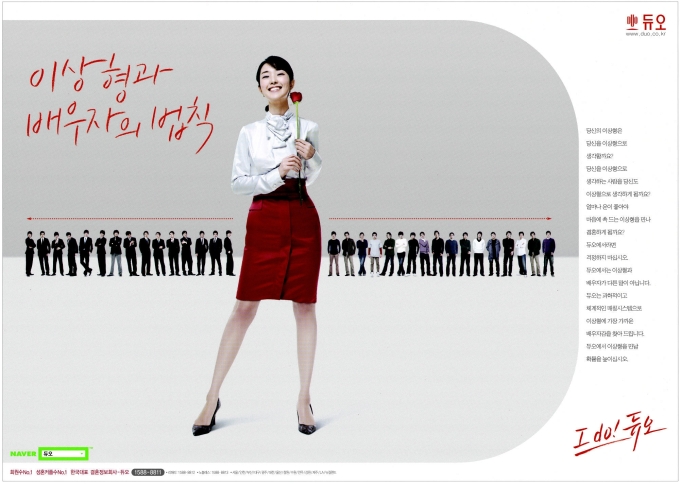 Never to be repeated? A Duo advertisement from 2008. Source: All4MAC.
Never to be repeated? A Duo advertisement from 2008. Source: All4MAC.
Finally, something I really wanted to find the answer for you here, but couldn’t sorry. Why do you think Korean marriage agencies “naturally” tend to have more female members, to the extent that that cohort of extra male customers in the 2010s seems to have been no more than the exception the proved the rule? Is the same true in other countries?
Please let me know in the comments below, or on Facebook or Twitter!
Related Posts:
- Korean Sociological Image #89: On Getting Knocked up in South Korea
- Korean Sociological Image #85: Just One 10 Minutes…to Improve Your Spouse’s Specs
- Korean Sociological Image #71: “Specs” for the perfect Korean wife or husband
- Korean Gender Reader
- Goodbye Madame Butterfly, Hello Sexless Marriage
- 중매결혼 Dana in (and out of) SoKo
- FTC Sues Owner of Online Dating Service Match.com for Using Fake Love Interest Ads To Trick Consumers into Paying for a Match.com Subscription Federal Trade Commission
If you reside in South Korea, you can donate via wire transfer: Turnbull James Edward (Kookmin Bank/국민은행, 563401-01-214324)

